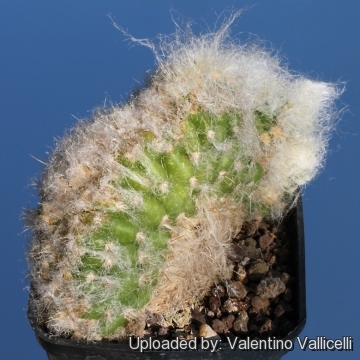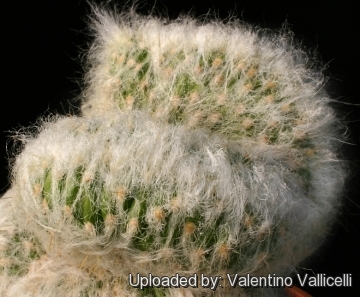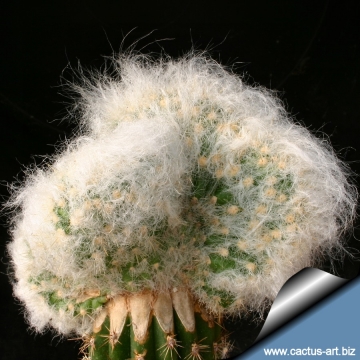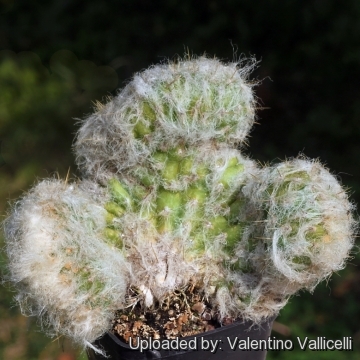
Oreocereus doelzianus var. sericatus f. cristata Photo by: Valentino Vallicelli
An attractive species that forms beautiful crest covered in long, white, hair-like spines (which becomes more dense in strong light)
Origin and Habitat: The department of Ayacucho, central Peru, on the western cordillera.
Habitat: Grows in high altitudes and are covered with wool as a protection against the cold.
Synonyms:
See all synonyms of Oreocereus doelzianus
Description: Bright green stems with blunt ribs that protrude less than 1 cm and are slightly prominent where the areoles are borne.
Areoles: circular, greyish-white and felted, separated by slight depressions,
Spines: stems are covered in long, white, hair-like spines (which becomes more dense in strong light) to protect them from the mountain cold and hot sun. Hidden in this white down are long, needle-like spines straw-coloured.
Crested form: This is an attractive plant that forms beautiful crest covered in long, white, hair-like spines (which becomes more dense in strong light)
Subspecies, varieties, forms and cultivars of plants belonging to the Oreocereus doelziarius group
- Oreocereus doelzianus (Backeb.) Borg: Cylindrical stems freely branching basally covered in white wool. Spines yellow to dark brown. Produces terminal cephalia with long white woolly hairs and whitish yellow bristles. Flowers borne from the cephalia, bluish carmine red. Distribution: central Peru.
- Oreocereus doelzianus subs. calvus (Rauh & Backeb.) Mottram
 Oreocereus doelzianus var. sericatus (F.Ritter) Lodé: Stems are covered in long, white, hair-like spines (which becomes more dense in strong light) to protect them from the mountain cold and hot sun. Hidden in this white down are long, needle-like spines straw-coloured.
Oreocereus doelzianus var. sericatus (F.Ritter) Lodé: Stems are covered in long, white, hair-like spines (which becomes more dense in strong light) to protect them from the mountain cold and hot sun. Hidden in this white down are long, needle-like spines straw-coloured. Oreocereus doelzianus var. sericatus f. cristata: Attractive species that forms beautiful crest covered in long, white, hair-like spines (which becomes more dense in strong light)
Oreocereus doelzianus var. sericatus f. cristata: Attractive species that forms beautiful crest covered in long, white, hair-like spines (which becomes more dense in strong light)
Bibliography: Major references and further lectures
1) Cáceres, F. & Ostalaza, C. 2013. Oreocereus doelzianus. In: IUCN 2013. "IUCN Red List of Threatened Species." Version 2013.2. <www.iucnredlist.org>. Downloaded on 17 February 2014.
2) David Hunt, Nigel Taylor “The New Cactus Lexicon” DH Books, 2006
3) Edward Anderson “The Cactus family” Timber Press, Incorporated, 2001
4) James Cullen, Sabina G. Knees, H. Suzanne Cubey "The European Garden Flora Flowering Plants: A Manual for the Identification of Plants Cultivated in Europe, Both Out-of-Doors and Under Glass" Cambridge University Press, 11/Aug/2011
 Oreocereus doelzianus var. sericatus f. cristata Photo by: Valentino Vallicelli
Oreocereus doelzianus var. sericatus f. cristata Photo by: Valentino Vallicelli Oreocereus doelzianus var. sericatus f. cristata Photo by: Valentino Vallicelli
Oreocereus doelzianus var. sericatus f. cristata Photo by: Valentino Vallicelli Oreocereus doelzianus var. sericatus f. cristata Photo by: Cactus Art
Oreocereus doelzianus var. sericatus f. cristata Photo by: Cactus Art Oreocereus doelzianus var. sericatus f. cristata Photo by: Valentino Vallicelli
Oreocereus doelzianus var. sericatus f. cristata Photo by: Valentino Vallicelli Oreocereus doelzianus var. sericatus f. cristata Photo by: Cactus Art
Oreocereus doelzianus var. sericatus f. cristata Photo by: Cactus Art Oreocereus doelzianus var. sericatus f. cristata Photo by: Valentino Vallicelli
Oreocereus doelzianus var. sericatus f. cristata Photo by: Valentino VallicelliCultivation and Propagation: Although regarded as a choice and difficult plant is not too difficult in a greenhouse, although grows quite slowly. It is sometime seen as a grafted plant but grows very well on its own roots too.
Soil: Use mineral well permeable mineral soil with little organic matter (peat, humus).
Exposure: They need a good amount of light shade to full sun this help to keep the plants healthy, although slow growth.
Watering: Water sparingly from March till October (weekly during summertime, if the weather is sunny enough) , with a little fertilizer added. Less or no water during cold winter months, or when night temperatures remain below 10° to prevent root loss. It is sensitive to overwatering (rot prone).
Fertilization: Feeding may not be necessary at all if the compost is fresh then, feed in summer only if the plant hasn't been repotted recently. Do not feed the plants from September onwards as this can cause lush growth which can be fatal during the darker cold months.
Hardiness: Keep perfectly dry in winter at temperatures from 5 to 15 degrees centigrade. (but it is relatively cold resistant and hardy to -5° C, or possibly colder for short periods) In the rest period no high atmospheric humidity!! (Temperature Zone: USDA 9-11)
Crested growth: Unlike 'monstrose' varieties of plants, where the variation from normal growth is due to genetic mutation, crested growth can occur on normal plants. Sometimes it's due to variances in light intensity, or damage, but generally the causes are unknown. A crested plant may have some areas growing normally, and a cresting plant that looks like a brain, may revert to normal growth for no apparent reason. If you have any of the crested part left you need to remove the normal growth and leave the crested part behind this will need to be done regularly.
Propagation: Grafting or cuttings. Plants are usually grafted onto column-shaped cacti but proved to be able to produce their own roots if degrafted. Cuttings will take root in a minimum temperature of 20° C (but better in hot weather). Cuttings of healthy shoots can be taken in the spring and summer. Cut the stem with a sharp, sterile knife, leave the cutting in a warm, dry place for a week or weeks (depending on how thick the cutting is) until a callus forms over the wound. Once the callus forms, the cutting may be inserted in a container filled with firmed cactus potting mix topped with a surface layer of coarse grit. They should be placed in the coarse grit only; this prevents the cut end from becoming too wet and allows the roots to penetrate the rich compost underneath. The cuttings should root in 2 to 6 weeks. Large crested piece must be placed on the soil surface without burying the plant base down in the soil.
















